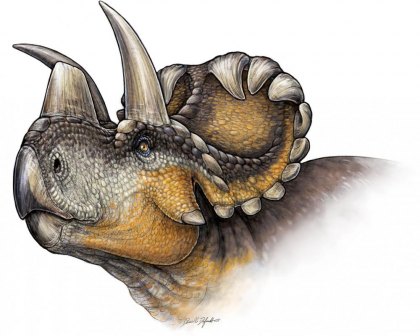
Its formal name is Wendiceratops pinhornensis. The dinosaur would have been about 20 feet long, weighed more than a ton and lived 79 million years ago, according to a news release from the Cleveland Museum of Natural History. A scientific paper on the dinosaur was published this week in PLOS-One, the Public Library of Science’s peer-reviewed journal.
Here is the rundown:
What’s in a name: In their research, the scientists -- David C. Evans, Department of Natural History, Royal Ontario Museum, and Michael J. Ryan, Department of Vertebrate Paleontology, Cleveland Museum of Natural History -- specifically thanked Wendy Sloboda, the Canadian fossil hunter who made the find five years ago in an Alberta quarry south of the Milk River. The dinosaur is named for her.
The project: This latest discovery is the outgrowth of the Southern Alberta Dinosaur Project, in which scientists are attempting to “fill in gaps in our knowledge of Late Cretaceous dinosaurs in North America,” according to the Cleveland Museum of Natural History.The Cretaceous period is defined by Encyclopedia Britannica as “the last of the three periods of the Mesozoic Era. The Cretaceous began 145 million years ago and ended 66 million years ago.”
Herb lover: The dinosaur was a herbivore. As described by the Cleveland Museum of Natural History, it possessed “a series of forward-curling hooklike horns along the margin of the wide, shieldlike frill that projects from the back of its skull.” It also had a horn above its nose.
About that nose horn: The research paper by Evans and Ryan describes the creature’s features. The dinosaur is “inferred to have a large, upright nasal horn located close to the orbits (eye sockets), which represents the oldest occurrence of this feature in Ceratopsia.”
So what is meant by Ceratopsia? As defined by Merriam Webster’s online dictionary, Ceratopsia refers to dinosaurs “having horns, a sharp horny beak, and a bony frill projecting backward from the skull.” (A commonly known example: the Triceratops.)
Sources:
- Cleveland Museum of Natural History: Curator Discovers New Horned Dinosaur Species.
- University of California Museum of Paleontology:Introduction to the Ceratopsians.
Related:
Newly identified dinosaur: A chicken from hell
If you would like to comment, contact StudyHall.Rocks or like us on Facebook and tell us what you think.